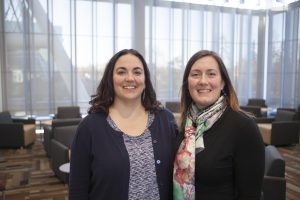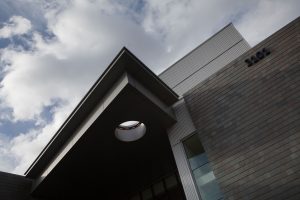Civil sisters celebrate women in engineering
by J. Besl |

Civil engineering sisters Melissa Branch, '00, and Stephanie Mormilo, '04, guide girls towards engineering careers through outreach and opportunities. (Photo by Phil Hall / University of Alaska Anchorage)
Melissa Branch and Stephanie Mormilo have a few things in common. They're both civil engineers (Melissa owns her own site design firm, Stephanie leads the city's traffic engineering team). They both lead the Alaska chapter of Society of Women Engineers (Stephanie is current president, Melissa was for seven years prior). They both graduated from UAA, and they both credit their father for pushing them towards this career path.
Oh, and of course, they're sisters too.
As a private site design specialist and a big-picture city employee, their professional paths don't always intersect. But they both credit UAA with the opportunities they've found in their Anchorage careers.
Melissa gave this year's keynote at Women in Engineering day on Nov. 4 at Cuddy Hall, which these sisters see as another opportunity to encourage young women the way their parents encouraged them.
'Dream job'
Melissa arrived at UAA with, admittedly, no idea what she wanted to do. "My dad convinced me," she said of her decision to study engineering. When Stephanie enrolled a few years later, it was easy to follow Melissa's path (plus, she got the same engineering talk from dad).
The university's affordability and connections boosted their career off the bat (especially for Stephanie, who graduated the first year of the UA Scholars program and had a full-ride waiting at UAA). "We both know people who went out of state and are doing what we do, and are paying off student loans," Melissa noted.
Both also appreciate the school's community connections. The curriculum is tailored to Alaska's unique environment, and is associated with several local engineering firms. For students who want to work in Anchorage, that combination is invaluable. "Alaska is a very small town, and the engineering community within Alaska is even smaller." Stephanie noted. "If you have a good reputation, if you work well with people, your name ends up all over the place."
Case in point: Steve Noble, head of transportation at local firm DOWL LLC (then DOWL engineers), taught Stephanie's upper-level transportation class. Impressed by her work and responsiveness, he offered her a job before she even graduated. "This school is what helped make that connection," she said.
Coincidentally, Melissa's career also started at DOWL, in site design (some of her projects include campus standouts like the ANSEP Building and the ConocoPhillips Integrated Science Building). When Melissa decided to shift to Enterprise Engineering, a smaller firm, several clients shifted their business to keep working with her.
"That was really when I realized the relationships I had," she said of the job change. "I had clients follow me that I didn't expect." That experience eventually led her to a major decision (again, following her dad's advice); in 2015, she launched her own firm, Big City Engineers.

In her first job after graduating, Melissa assisted the design of campus landmarks like the ConocoPhillips Integrated Science Building and ANSEP Building. (Photo by Phil Hall / University of Alaska Anchorage)
Stephanie also made a big move in her career, being named the city's lead traffic engineer at the age of 29. As a homegrown Anchorage resident, she saw leading the city's transportation department as an "eventual dream job." But when the position opened, her engineering connections recommended her. The job came with a lot of pressure and a lot of expectations (as Stephanie says, everyone complains about weather and traffic, but only one of those can be addressed by the city).
Leading a municipal traffic department in a city larger than Rhode Island? Launching a private firm during a down economy? Both choices sound anxiety inducing. "You're excited and terrified at the same time," Melissa said of starting her business, and Stephanie agreed. But they wouldn't look back.
Outreach in engineering
Both sisters are professional, successful and relatable engineers. They've seen the benefits of UAA, and they're the perfect pair to share them.
Melissa sits on the College of Engineering advisory board (which Stephanie will soon join), and they're both involved in Society of Women Engineers (SWE), a national organization promoting the value and potential of women in a typically male-dominated field.
Like many of their peers, both Melissa and Stephanie have experienced a lack of representation, even in crowded meetings. "Most days you don't even notice it," Melissa said, "but every once in a while, you're like... I am the only woman in this room."
Through their work with SWE, they try to steer young women toward careers in engineering through one-on-one mentorship, science days for Girl Scouts troops and involvement with high school engineering academies. "[We want to] show them there's a wide variety of us and the things that we do," said Melissa.
That's not to exclude men from the conversation. "Some of our biggest supporters-our dad, my husband-are the men in our lives," Melissa continued. "It's really recognizing that women learn different, we are different, and providing those opportunities... I don't remember ever meeting engineers and having those opportunities."
"The outreach really is a big part of it," Stephanie added, describing activities-building newspaper towers, the classic egg-drop test-that provide a window into the social development of girl world. "Little girls we work with will dive right in," Stephanie noted. "Younger girls really want to challenge themselves and, unfortunately, we've had some experiences with middle schoolers where they just give up."
They combat that middle school malaise by asking questions, guiding directions, shifting perceptions of a problem and providing a chance, as Melissa said, for girls to "think about failure differently."
"In our job, there's never a right answer," she continued. "You can always tweak it a little better."
It all comes back to another lesson learned from their dad; there are no stupid questions, just stupid mistakes you made because you didn't ask.
Perhaps the most personally important factor of leading SWE is the opportunity to give back. Their dad always wanted to establish an engineering scholarship in Alaska. He passed away eight years ago this November and, in his memory, the family started a fund under the SWE banner in his honor. This year, Melissa, Stephanie and their mother will award an eighth young woman their family's scholarship.
Women in Engineering Night on Nov. 4
At the Women in Engineering keynote, Melissa certainly had a lot to talk about. She's found that many college students are curious about the life after college-work-life balance, starting a family, everything a college course won't cover.
On that note, she also has a message of empowerment. Though Stephanie is an unabashed extrovert, Melissa isn't. But she's built confidence over her career, from a college freshman afraid to ask questions to owner of her own engineering firm.
Audience aside, she's already inspired one woman in engineering
"Melissa-she's my idol. She's my older sister. She is why I have always challenged myself to do better," Stephanie said. "Seeing what she's done with her career and how she's challenged herself and how she's grown... she amazes me every day with the things she does."
For more information on Society of Women Engineers, visit their Alaska chapter website.
 "Civil sisters celebrate women in engineering" is licensed under a Creative Commons Attribution-NonCommercial 4.0 International License.
"Civil sisters celebrate women in engineering" is licensed under a Creative Commons Attribution-NonCommercial 4.0 International License.














